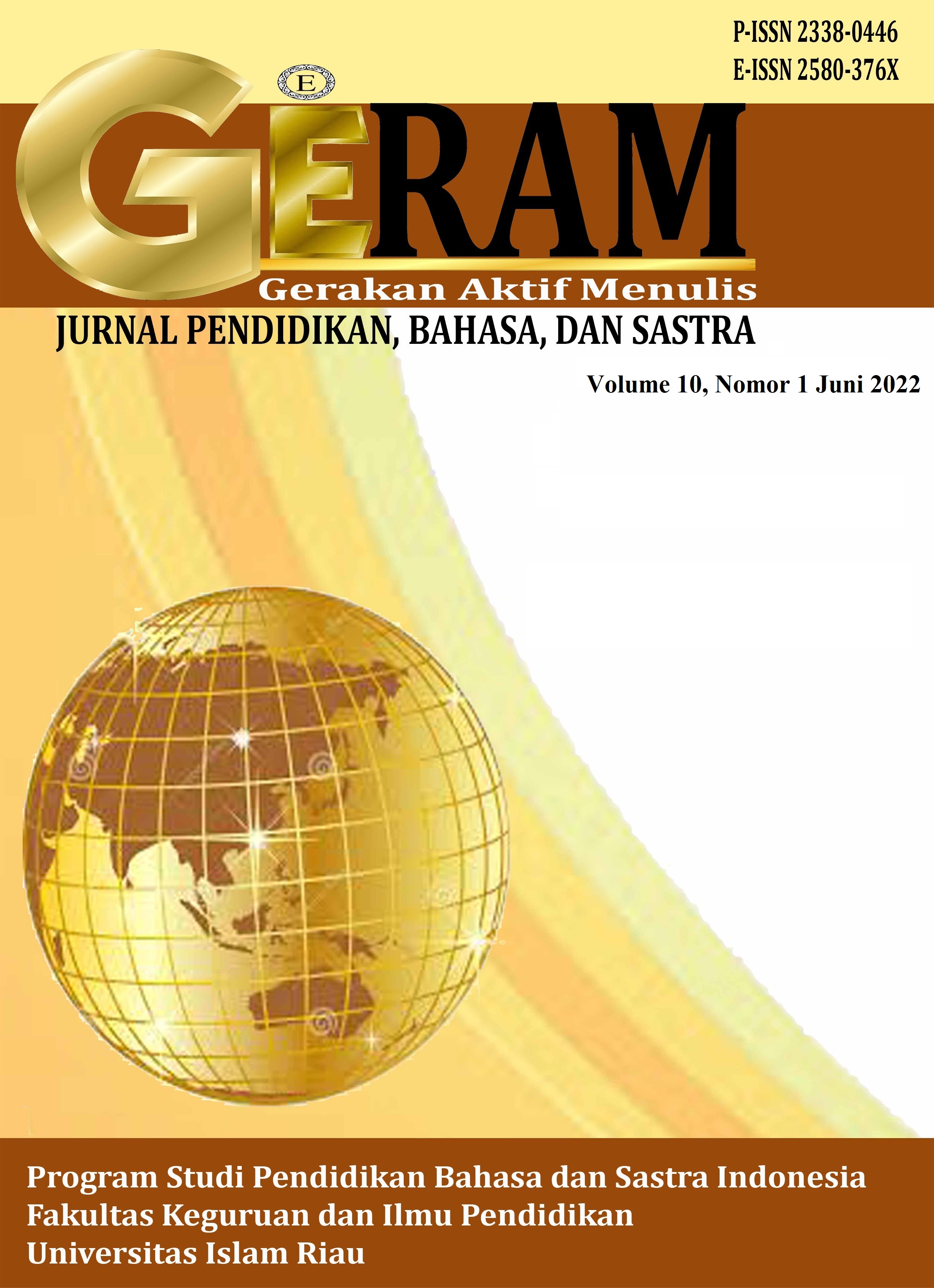Sarkasme Pada Meme di Media Sosial Instagram
Keywords:
memes, figurative language, sarcasm, meanings, stylisticAbstract
This study aims to determine the stylistic style of Sarcasm in Indonesian memes on Instagram. This study takes a formal object, namely stylistics, and a material object in the form of Indonesian memes on Instagram. The two objects were appointed as research material because they were motivated by meme problems and at least stylistic research in linguistics. The purpose of this study was to determine the analysis of memes through stylistic studies. The method used in this research is descriptive research in the form of qualitative. The data used is in the form of memes taken on Instagram with the condition that the meme uses language styles and language symptoms (majas). The results of this research data analysis are: (1) memes use language as a medium, including written language and images that are mutually supportive for the emotional formation of readers. (2) memes have language style and language symptoms. (3) memes use more than one figure of speech. With the existence of memes in the digital world, such as creating memes in this satirical review, the creative platform for reviews becomes open and diverse. Memes can be humorous as well as thought-provoking material about what's going on. So the meme became a new reaction to the events of the nation, especially in political and social life. Memes clarify attitudes of criticism and irony, but can also create irony and criticism in humour.
Downloads
References
Burling, R., Armstrong, D. F., Blount, B. G., Callaghan, C. A., Foster, M. L., King, B. J., Parker, S. T., Sakura, O., Stokoe, W. C., & Wallace, R. (1993). Primate calls, human language, and nonverbal communication [and comments and reply]. Current Anthropology, 34(1), 25–53.
Cahyanto, R. J. (2017). Analisis Gaya Bahasa Meme Di Media Sosial Instagram.
Chaer, A. (2007). Kajian bahasa: struktur internal, pemakaian, dan pemelajaran. Rineka Cipta.
Funk, T. (2014). Advanced social media marketing: How to lead, launch, and manage a successful social media program. Apress.
Gibbs, R. W. (1986). On the psycholinguistics of sarcasm. Journal of Experimental Psychology: General, 115(1), 3.
Gibbs, R. W. (2007). On the psycholinguistics of sarcasm. Irony in Language and Thougt: A Cognitive Science Reader, 173–200.
González-Ibánez, R., Muresan, S., & Wacholder, N. (2011). Identifying sarcasm in twitter: a closer look. Proceedings of the 49th Annual Meeting of the Association for Computational Linguistics: Human Language Technologies, 581–586.
Gorys Keraf, D. (2009). Diksi dan gaya bahasa. Gramedia Pustaka Utama.
Hadas, L., & Shifman, L. (2013). Keeping the elite powerless: Fan-producer relations in the “Nu Who”(and new YOU) era. Critical Studies in Media Communication, 30(4), 275–291.
Handayani, E. N., & Chasanah, S. N. (2019). Representasi Kehidupan Dalam Program Meme di Instagram: Analisis Wacana Kritis Model Norman Fairclough. Proceeding of The URECOL, 180–184.
KBBI, K. (2016). Kamus Besar Bahasa Indonesia (KBBI). Kementerian Pendidikan Dan Budaya.
Kerbrat-Orecchioni, C. (1986). Nouvelle communication» et «analyse conversationnelle. Langue Française, 70, 7–25.
Kostadinovska-Stojchevska, B., & Shalevska, E. (2018). Internet memes and their socio-linguistic features. European Journal of Literature, Language and Linguistics Studies, 2(4).
Nugraha, A., Sudrajat, R. H., & Putri, B. P. S. (2015). Fenomena Meme Di Media Sosial (Studi Etnografi Virtual Posting Meme Pada Pengguna Media Sosial Instagram). Jurnal Sosioteknologi, 14(3), 237–245.
Nurgiyantoro, B. (2005). Tahapan perkembangan anak dan pemilihan bacaan sastra anak. Yogyakarta State University.
Prihastuti, A. K. K., Suwena, K. R., & Sujana, I. N. (2019). Analisis Kinerja Keuangan Dengan Menggunakan Common Size Pada Perusahaan Otomotif Yang Terdaftar Di Bursa Efek Indonesia (BEI) Tahun 2016. Jurnal Pendidikan Ekonomi Undiksha, 11(1), 11–20.
Pusanti, R. R. (2015). Representasi Kritik dalam Meme Politik (Studi Semiotika Meme Politik dalam Masa Pemilu 2014 pada Jejaring Sosial” Path” sebagai Media Kritik di Era Siber).
Rohmadi, A. (2016). Tips produktif ber-social media. Elex Media Komputindo.
Sudarsono, S. C. (2017). Representasi Masyarakat Indonesia Melalui Ketidakjujuran yang Tecermin dalam Meme “Awas Itu Hoax.” Konferensi Linguistik Tahunan Atma Jaya, 15.
Sugiyono, D. (2013). Metode penelitian pendidikan pendekatan kuantitatif, kualitatif dan R&D.
Trevisan, D. A., Abel, E. A., Brackett, M. A., & McPartland, J. C. (2021). Considerations About How Emotional Intelligence can be Enhanced in Children With Autism Spectrum Disorder. Frontiers in Education, 6, 639736.
Wadipalapa, R. P. (2015). Meme culture & komedi-satire politik: kontestasi pemilihan presiden dalam media baru.
Zaimar, O. K. S. (2002). Majas dan pembentukannya. Makara Human Behavior Studies in Asia, 6(2), 45–57.
Zubaidah, N., & Ardelia, I. (2018). A Discourse analysis of memes. Getsempena English Education Journal, 5(2), 58–64.

















